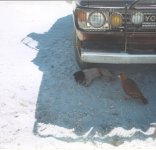After having seen that this is still considered "un-id'ed" I'll do another thread on it. It's a juvenile Mountain Caracara. 110% sure! I have seen hundreds, and they all look exactly like that one. I have also seen hundreds of the various other species it was said it could look like... and it's not. Anyways, here's why:
Compared with Yellow-headed or Chimango:
Overall uni-coloured brown. This is NEVER seen in Yellow-headed or Chimango; no matter if they're juv's, immatures or adults. They always appear much more speckled especially below and/or on head. Only fully adult plumaged Yellow-headed are non-speckled (it's the last thing that is lost), but they always have an eye-stripe+different back colour versus chest & head+striped tail+... in short; a very different bird. Neither Chimango or Yellow-headed has ever been reportet anywhere near this altitude, and both are conspicious species so their distributions are clearly understood.
Compared with Carunculated Caracara:
First it is totally out of range! Yet again a very conspicious species, so range is well understood. Even if we assumed it was possible (as it is in a limited zone of Ecuador), the bare skin does NOT extend behind the eye, which it does in both juv./imm./ad. Carunculated.
In short: The bird on the photo even shows hints of cinnamon on the wings and a cinnamon undertail! It's just about the most perfect juv. Mountain Caracara you will ever see!
Ohh, I forgot: Yes, the dog probably survived the encounter

Mountain Caracara's prefer to scavenge. Otherwise they mostly take rather small or weak animals.




